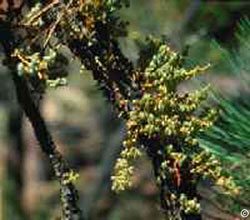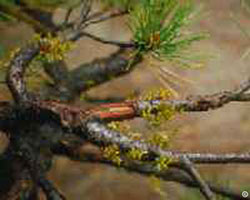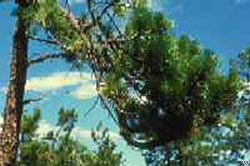 Dwarf mistletoes are small, leafless, parasitic flowering plants. They cause major damage to ponderosa, lodgepole, limber and pinyon pines as well as Douglas fir. Hardwood trees aren’t affected.
Dwarf mistletoes are small, leafless, parasitic flowering plants. They cause major damage to ponderosa, lodgepole, limber and pinyon pines as well as Douglas fir. Hardwood trees aren’t affected.
Infection starts when a dwarf mistletoe seed comes into contact with a suitable host. The stickey seeds discharge explosively at speeds up to 60 miles per hour, adhering to any surface they strike. As the seed germinates, it grows into the bark and tissue of the host tree. The parasite produces root-like structures called sinkers that take water and nutrients from the host.

Tree death occurs slowly as it is robbed of essential water and nutrients year after year. Look for yellow foliage and branch mortality in the upper portion of a tree. The parasite is identifiable when its yellow to green to brownish-green segmented shoots protrude from the infected part of a tree. These woody shoots are one-half inch to six inches long and one-eighth inch to one-fourth inch in diameter. Shoots form two to three years after infection. As a tree dies, it will suffer growth reduction, loss of wood quality, poor tree form, predisposition to insect and disease problems, and reduction in seed crops.
 The best management strategy is to prune out infected branches. If possible, completely remove severely infected trees. If they aren’t removed, trees with high, unreachable mistletoe infections will continue to shower seeds on nearby trees. Thirty percent to 40 percent of the branches from the top down should be retained during pruning, even if it means leaving some infected branches.
The best management strategy is to prune out infected branches. If possible, completely remove severely infected trees. If they aren’t removed, trees with high, unreachable mistletoe infections will continue to shower seeds on nearby trees. Thirty percent to 40 percent of the branches from the top down should be retained during pruning, even if it means leaving some infected branches.
Replace removed trees with dwarf mistletoe resistant species such as Austrian, mugo or Scotch pine.
For more information, see the following Colorado State University Extension fact sheet(s).



